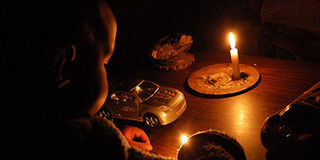Blackouts looming as water level falls in dam

Dark nights would mean more of these scenes in houses. Photo / JOSEPH KANYI
Masinga Dam, the uppermost in the Seven Forks cascade, is threatened with closure due to falling water levels.
Last week the dam, which produces 40MW but has dropped to 18MW, was tottering at less than a metre from its lowest point.
This could mean shortage of electricity for domestic and industrial consumers and a possible rise in rates. There has been inadequate rainfall in the catchment area, despite early predictions that rains would significantly replenish the water.
“It has improved a little but we are not out of the woods yet and hope the rains will continue. Masinga Dam is 1,037.75 metres above sea level and below this we cannot produce and water has to be opened and fed into other dams downstream,” said KenGen Managing Diector Eddy Njoroge, who toured some of the dams last week.
Spill-over
He said they had projected that with the onset of the rains in mid April Masinga Dam would rise to 1,049 metres by June. The dam spills off at 1,056.5 metres and is 20 metres below the spilling level. Construction work to raise the spillover to 1,566 metres.
Masinga Dam is at the head of the cascade of four dams — Kamburu, Kiambere, Gitaru and Kindaruma — and is a major supplier of hydroelectricity. The dam serves as water storage facility for downstream dams.
The Seven Forks provide 47 per cent of Kenya’s electricity. As a result of anticipated low power production, the government has shelved plans to retire 50MW of diesel-powered generation to bridge the shortfall.
High costs
The last time Kamburu Dam attained such low levels of water was in 2000 at 1,018 metres above sea level, resulting in its closure. The period was marked with intermittent blackouts and high electricity costs as the government invited independent power producers (IPPs) to supply electricity.
According to engineers at Masinga, water inflows have been poor since May 2007. In April KenGen and Kenya Power and Lighting Company had warned that it would be impossible to maintain adequate power generation at the dam if the rains were not adequate.
KPLC in January started contingency measures by tendering for three 60MW to 80MW diesel powered plants, which has shorter lead time before production starts.
However, unlike in 2000 when the alternatives were limited, the government expects various power generation projects being carried out will bridge the shortfall and ease pressure on the national grid.
Such projects like Mumias Sugar Company’s bagasse fired co-generation, currently under trial is expected to inject 26MW,while Iberafrica is expected to bring in another fuel oil fired 22.5 MW, and Rabai Power is expected to add 88.3MW.
Growing demand
KenGen is seeking a Sh15 billion bond to step up energy production. The country has an installed capacity of 1,331MW against effective demand of 1,245MW, which leaves less than the 15 per cent recommended reserve.
Hydro power has effective capacity of 692MW, geothermal has 163MW, while thermal has 390MW and emergency power 146MW. According to the national power development plan, 1623MW will be added to the national grid by 2015 against the forecast demand of 2242MW.




